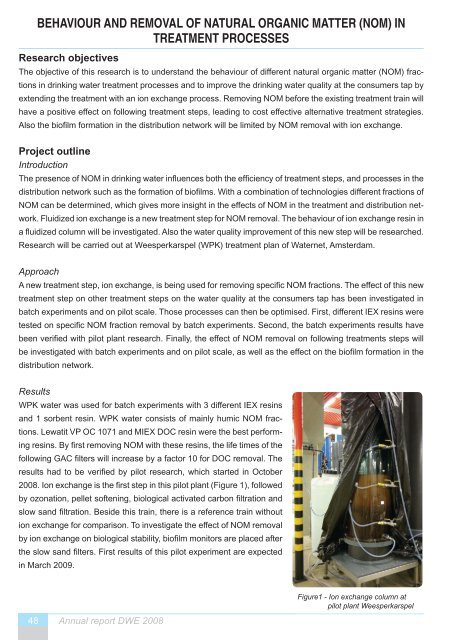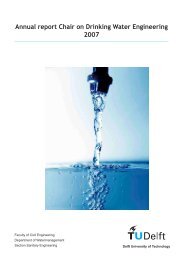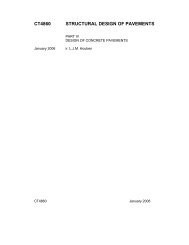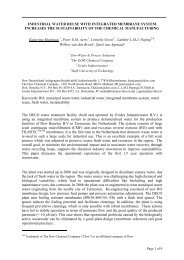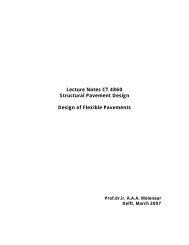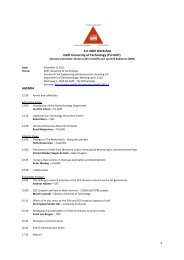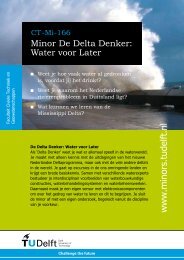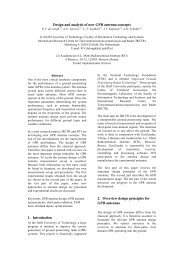Annual report Chair on Drinking Water Engineering 2008 - TU Delft
Annual report Chair on Drinking Water Engineering 2008 - TU Delft
Annual report Chair on Drinking Water Engineering 2008 - TU Delft
You also want an ePaper? Increase the reach of your titles
YUMPU automatically turns print PDFs into web optimized ePapers that Google loves.
ehaviour and reMoval of natural organic Matter (noM) in<br />
treatMent Processes<br />
Research objectives<br />
The objective of this research is to understand the behaviour of different natural organic matter (NOM) fracti<strong>on</strong>s<br />
in drinking water treatment processes and to improve the drinking water quality at the c<strong>on</strong>sumers tap by<br />
extending the treatment with an i<strong>on</strong> exchange process. Removing NOM before the existing treatment train will<br />
have a positive effect <strong>on</strong> following treatment steps, leading to cost effective alternative treatment strategies.<br />
Also the biofilm formati<strong>on</strong> in the distributi<strong>on</strong> network will be limited by NOM removal with i<strong>on</strong> exchange.<br />
Project outline<br />
Introducti<strong>on</strong><br />
The presence of NOM in drinking water influences both the efficiency of treatment steps, and processes in the<br />
distributi<strong>on</strong> network such as the formati<strong>on</strong> of biofilms. With a combinati<strong>on</strong> of technologies different fracti<strong>on</strong>s of<br />
NOM can be determined, which gives more insight in the effects of NOM in the treatment and distributi<strong>on</strong> network.<br />
Fluidized i<strong>on</strong> exchange is a new treatment step for NOM removal. The behaviour of i<strong>on</strong> exchange resin in<br />
a fluidized column will be investigated. Also the water quality improvement of this new step will be researched.<br />
Research will be carried out at Weesperkarspel (WPK) treatment plan of <strong>Water</strong>net, Amsterdam.<br />
Approach<br />
A new treatment step, i<strong>on</strong> exchange, is being used for removing specific NOM fracti<strong>on</strong>s. The effect of this new<br />
treatment step <strong>on</strong> other treatment steps <strong>on</strong> the water quality at the c<strong>on</strong>sumers tap has been investigated in<br />
batch experiments and <strong>on</strong> pilot scale. Those processes can then be optimised. First, different IEX resins were<br />
tested <strong>on</strong> specific NOM fracti<strong>on</strong> removal by batch experiments. Sec<strong>on</strong>d, the batch experiments results have<br />
been verified with pilot plant research. Finally, the effect of NOM removal <strong>on</strong> following treatments steps will<br />
be investigated with batch experiments and <strong>on</strong> pilot scale, as well as the effect <strong>on</strong> the biofilm formati<strong>on</strong> in the<br />
distributi<strong>on</strong> network.<br />
Results<br />
WPK water was used for batch experiments with 3 different IEX resins<br />
and 1 sorbent resin. WPK water c<strong>on</strong>sists of mainly humic NOM fracti<strong>on</strong>s.<br />
Lewatit VP OC 1071 and MIEX DOC resin were the best performing<br />
resins. By first removing NOM with these resins, the life times of the<br />
following GAC filters will increase by a factor 10 for DOC removal. The<br />
results had to be verified by pilot research, which started in October<br />
<strong>2008</strong>. I<strong>on</strong> exchange is the first step in this pilot plant (Figure 1), followed<br />
by oz<strong>on</strong>ati<strong>on</strong>, pellet softening, biological activated carb<strong>on</strong> filtrati<strong>on</strong> and<br />
slow sand filtrati<strong>on</strong>. Beside this train, there is a reference train without<br />
i<strong>on</strong> exchange for comparis<strong>on</strong>. To investigate the effect of NOM removal<br />
by i<strong>on</strong> exchange <strong>on</strong> biological stability, biofilm m<strong>on</strong>itors are placed after<br />
the slow sand filters. First results of this pilot experiment are expected<br />
in March 2009.<br />
48 <str<strong>on</strong>g>Annual</str<strong>on</strong>g> <str<strong>on</strong>g>report</str<strong>on</strong>g> DWE <strong>2008</strong><br />
Figure1 - I<strong>on</strong> exchange column at<br />
pilot plant Weesperkarspel


